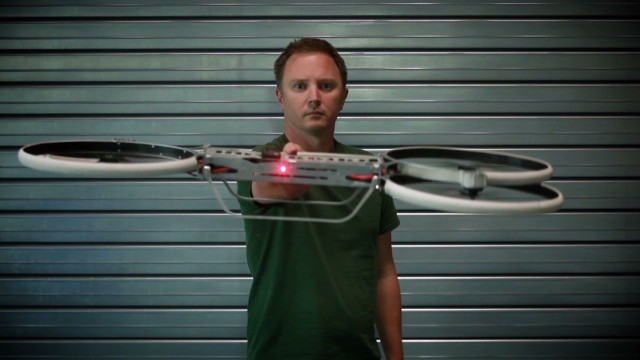Make, Create, Innovate
is a science and technology series that tells the stories behind the
inventions and technological breakthroughs that are reshaping our world.
(CNN) -- Ger Jansen is puzzling about how to fit a
windshield. His problem is not installing it in a car, but hanging the
glass in thin air and keeping it hovering for a prolonged display.
This is a fairly typical challenge for the Dutch engineer, who along with his daughter Angela runs Crealev,
a leading levitation design firm. The mysterious art of floating has
been largely confined to ultra-specialist industry applications and
magician tricks, but the Jansens have developed a repertoire for any
occasion; from lifting a model's top hat for a fashion shoot to a giant
rock in a striking art display. They have given sneakers air for Nike,
and produced a range of self-suspending lamps for the home.
These are all given
flight by patented modules that induce magnetic levitation. The kit is
comprised of two parts: a magnetic disc that can be integrated into the
chosen object, and a base containing sensors that pin it in space. The
latest and most heavy-duty module can support up to 10 kilograms to a
height of nine centimeters, but bespoke services are available for
unlimited height and weight.
"Our customers drive us
by requesting more demanding solutions," says Jansen. "For the higher
and heavier loads we have to combine the largest levitation modules."
The company is also
developing programming to make the magnets smarter, more responsive and
capable of more sophisticated movement.
"People don't want
something to just float but also to interact with it. What should happen
then is that sensors around the object move depending on the movement
of people, so the object is more intelligent."

Jansen is flooded with
requests to make every conceivable item levitate. One popular option for
illusionists and thrill-seekers is to make a human float, which he is
pursuing with some reservations.
"You could have magnets
inserted into clothes but it would not feel like resting on the clouds
... If you have these magnets working together it's a giant force. It
can hurt the skin. There need to be safety precautions."
The Jansens are not alone as there is a growing market of levitating applications for consumers. A Californian company
has released a set of floating speakers, promising a unique experience
for the listener. Czech designers have produced a computer mouse buoyed by magnetic levitation, designed to alleviate carpal tunnel syndrome.
But the limiting factor
of magnetic levitation is requiring a base to float over, effectively
requiring that objects are stationary. This largely puts paid to the
hoverboard dream inspired by "Back to the Future" -- another of the
Jansens' most common requests -- and explains why transport seems the
best placed industry to make use of the technique.
Until recently, "Maglev"
trains were expected to revolutionize public transport, promising
increased speeds over 300mph. But the high cost and energy consumption
has slowed their growth and today only China and Japan operate such a
system.
That could change with
the advent of superconductor-powered vehicles, able to generate greater
magnetic force with lower power consumption. High concept projects such
as China's 'Super Maglev' would use this system for supersonic transport, and it could even support space missions.
Dr. Ludwig Schultz of Dresden' Institute for Metallic Materials works with maglev vehicles and feels superconduction offers significant advantages.
I would like to draw huge levitated graphics in stadiums or concerts
Yoichi Ochiai, Lead Researcher, University of Tokyo
Yoichi Ochiai, Lead Researcher, University of Tokyo
"It gives you much more
freedom. The energy storage is more efficient, and there are no moving
parts. It can be extremely fast with frictionless motion."
Schultz has developed
his own superconducting levitating vehicle -- the "Supratrans," a
lightweight buggy that hovers above tracks, held in place with a
self-stabilizing mechanism. He imagines it being used for rapid
transfers in airports, although one research area looks at creating
routes and vehicles for private use.
The applications from
superconductors need not be limited to transport, says Schultz. He has
consulted on projects to float a 60-ton stage, and to enhance gravity in
space, among other ambitious plans.
Another levitation
breakthrough has come at the micro level, and by a different method.
This year, Japanese scientists used acoustic levitation to manipulate
small objects with three-dimensional capability for the first time.
Researchers created a "moveable ultrasonic focal point" that allowed
them unprecedented control with sound waves.
Experts hailed the
potential impact for molecular analysis for chemistry and medicine, but
lead researcher Yoichi Ochiai of the University of Tokyo also foresees
wider applications: "I would like to draw huge levitated graphics in
stadiums or concerts," he said. "Or for use in our daily lives such as
floating interactions at home and small object levitation."
In many cases,
levitation technologies have yet to find meaningful functions, either
serving novelty purposes or yet to break out of the research stage. But
the possibilities are multiplying, and the applications are becoming
established in fields such as entertainment and transport.
If the spread continues, magicians may need to learn some new tricks. LINK


